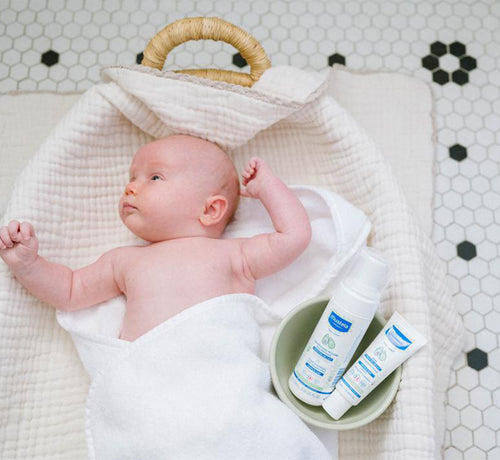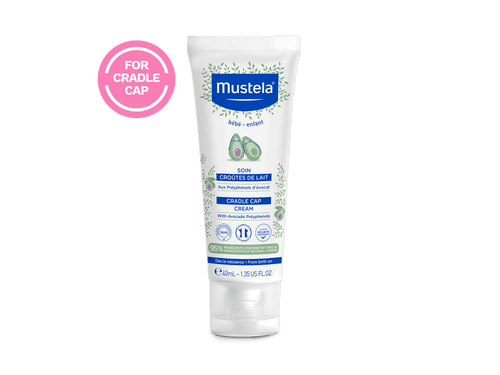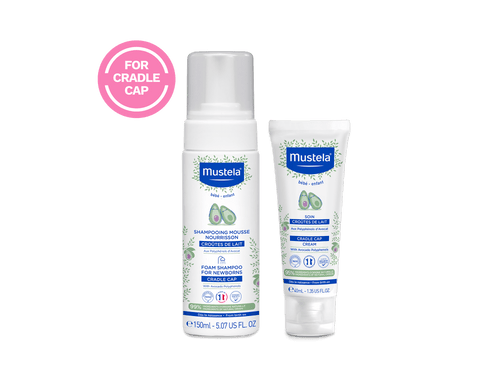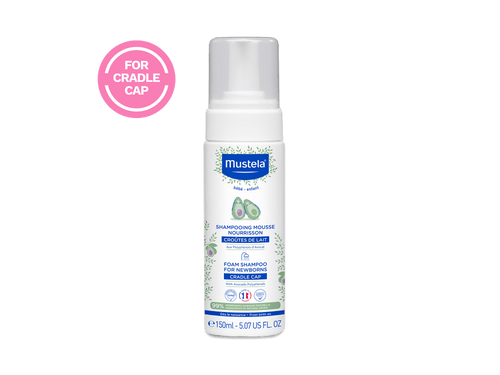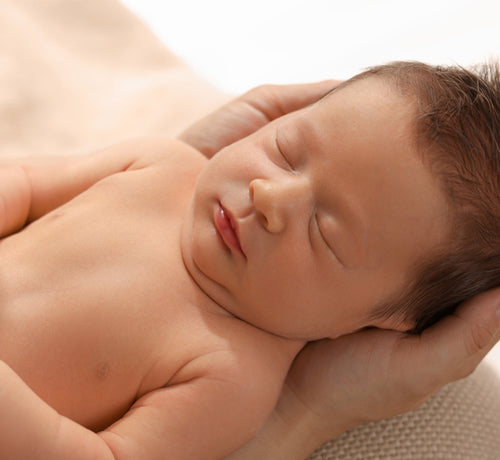You’ve just welcomed your new little one into the world, and it’s a joyous time. But amidst all the adorable facial expressions and coos, you notice your baby’s scalp showing signs you didn’t anticipate — flaky, dry patches. And now you’re wondering, when does cradle cap start?
And, if this is cradle cap, what can you do about it? We’ll walk you through everything from what cradle cap is to when it starts and how to manage the symptoms.
Table Of Contents
What Is Cradle Cap?

Cradle cap (also known as seborrheic dermatitis) is a common skin condition that affects many newborns. It typically appears as greasy, flaky patches on the scalp but can also be found on other body parts, including the:
- Face
- Ears
- Neck
- Diaper area
This condition is not contagious or harmful to your baby’s health, though it may cause mild discomfort or itchiness.
Causes
The exact cause of cradle cap is unknown, but it’s believed to be related to an overproduction of oil in the skin, which can lead to the buildup of scales. Hormones may also play a role, as your baby may still have residual hormones from pregnancy or breastfeeding.
Scientists are also investigating a type of yeast that’s found on the skin, called Malassezia. They suspect it could be the culprit for some cases of cradle cap.
Additionally, this condition is more common in babies with a family history of eczema, allergies, or asthma. However, more research is needed to fully understand the connection.
It’s important to note that cradle cap is not caused by poor hygiene. Nothing you did (or didn’t do) caused the flakes to appear.
Symptoms
If your little one has cradle cap, you’ll likely notice the following symptoms:
- Flaky skin on their scalp that feels greasy
- Thick yellow or white scales
- Redness
- Crusty areas
In some cases, cradle cap can also lead to temporary hair loss. This happens because the hair gets stuck to the greasy patches of skin and falls out when the scales come off.
But don’t worry. It’s not permanent, and your baby’s hair growth should return to normal once the condition clears up.
When To See The Doctor
Cradle cap typically clears up on its own without medical intervention. But if you’re concerned about your baby’s skin, it’s always best to consult their pediatrician.
Here are some instances when you should make an appointment:
- The affected area is spreading beyond the scalp to other areas of the body
- The patches look inflamed and swollen
- Your baby seems extremely itchy or uncomfortable
- The condition doesn’t improve after a few weeks of home treatment or appears to be getting worse
- Your baby is losing a lot of hair
- You suspect the symptoms aren’t from cradle cap but from a different skin condition like eczema
In rare cases, cradle cap can lead to a bacterial or fungal infection. If you notice any signs of infection, such as oozing or foul-smelling discharge from the affected area, consult your doctor immediately. They may prescribe an antifungal or antibiotic to help treat the problem.
When Does Cradle Cap Start?

Now that you know more about the signs of cradle cap, let’s talk about when it typically appears.
Newborns are most susceptible to cradle cap. You’ll likely notice symptoms between two weeks and three months old. However, some babies develop the condition a bit earlier or later in life. Some are even born with it.
Regardless of when it starts, cradle cap is usually a temporary condition that will resolve itself as your baby grows and develops.
When Does Cradle Cap Go Away?
Those pesky flakes won’t last forever. Cradle cap usually clears up within a few weeks of starting treatment. And even if you decide not to treat it, symptoms typically disappear by the time your baby turns one.
Cradle Cap Treatment
Cradle cap isn’t a dangerous condition, and its treatment is considered optional. That said, many parents decide to treat it for their baby’s comfort and to improve the appearance of their scalp and hair.
If you want to start treatment at home, the following tips can help.
Wash Baby’s Hair With Moisturizing Shampoo
While most babies don’t need a bath every day, consider washing your little one’s hair several times a week with a moisturizing shampoo that’s labeled for cradle cap, like Mustela Foam Shampoo for Newborns.
This shampoo is:
- Enriched with mild, plant-based surfactants to gently cleanse your baby’s delicate skin without overdrying
- Hypoallergenic and free from parabens, phthalates, and phenoxyethanol
- Formulated with Avocado Polyphenols® and Sunflower Seed Oil to keep their scalp hydrated
Keeping your baby’s hair clean can reduce the buildup of oil that cradle cap causes and reduce the severity of their symptoms.
Avoid Harsh Ingredients
No matter what brand of shampoo you use, pick one that’s safe for use on newborns. The ingredients in adult skincare products can be too harsh for your little one’s sensitive skin.
Avoid shampoos containing perfumes, fragrances, artificial colors, sulfates, or other irritating ingredients. These can cause further problems with your baby’s scalp.
Use A Soft Brush
While your baby is in the bath, use a soft-bristled brush or a baby comb to gently massage their scalp. This can help loosen any flakes or scales.
After brushing, rinse your baby’s scalp carefully with fresh water to remove any loosened bits of skin.
Try An Overnight Cream
If you don’t notice your baby’s cradle cap symptoms improving through washing alone, it might be time to try an overnight cream specifically designed to moisturize the skin and soften the scales.
Our Cradle Cap Cream is a great choice. In a clinical study, 92% of users agreed that this product quickly eliminated cradle cap.
It contains natural ingredients such as Avocado Polyphenols®, Sunflower Oil Distillate®, and Galactoarabinan (an extract from the Larch tree) to help eliminate cradle cap flakes and prevent future recurrences.
For best results, apply this cream daily to the affected area. The unique nozzle design makes it easy to get the cream exactly where it’s needed.
Once you apply the cream, leave it on overnight and rinse it out the following day with our Foam Shampoo for Newborns. These two products make up our popular Cradle Cap Duo. They work together to effectively and gently tackle cradle cap.
Avoid Picking The Flakes
When you see flaky patches on your newborn’s head, you might be tempted to pick them off. But if you do that, you could cause the skin to become red and inflamed. Picking or scratching the flakes can also lead to an infection, making treatment more challenging.
Instead, resist the urge to pick and use the strategies mentioned above to help loosen the flakes. Then, you can brush them off in the tub.
Continue Treating Once Symptoms Disappear
Just because your baby’s scalp no longer has thick patches of skin doesn’t mean you should stop treatment right away. If you do, the symptoms could come back again.
Continue using the specialized products for a few more weeks to help prevent future recurrences.
When Cradle Cap Starts, Turn To Mustela

Let’s wrap this up with a quick review: When does cradle cap start?
This common condition typically appears during the first few weeks of a baby’s life. It may cause flaky, oily patches on the scalp or other body parts.
Should you pick off the flakes from cradle cap?
No! Picking your baby’s scalp is a bad idea. It can cause irritation and infection.
What’s the best way to treat cradle cap?
Harness the healing power of nature and use the Mustela Cradle Cap Duo to remove the flakes and soothe your baby’s skin. Apply the Cradle Cap Cream to their scalp in the evening and let it sit overnight. Then, wash it out in the morning with the Foam Shampoo for Newborns.
With patience, gentle care, and Mustela products, you can say goodbye to cradle cap and hello to a happy, healthy scalp!


